Description
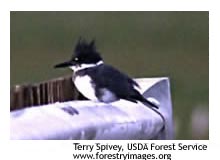 The belted kingfisher is a stocky bird. It is 11-14 inches in length with a wingspan of
18-23 inches. It has a large head with a shaggy crest; a long, thick, sharp bill; small legs and feet; a white spot by its eyes; and a short barred tail. It is slate blue on its head, upper breast, back, wings, and tail. It has a white belly, a white collar around its neck, and a slate-blue breast band. Males and females look alike, but the female may have rusty red band on her belly. The belted kingfisher is a stocky bird. It is 11-14 inches in length with a wingspan of
18-23 inches. It has a large head with a shaggy crest; a long, thick, sharp bill; small legs and feet; a white spot by its eyes; and a short barred tail. It is slate blue on its head, upper breast, back, wings, and tail. It has a white belly, a white collar around its neck, and a slate-blue breast band. Males and females look alike, but the female may have rusty red band on her belly.
Range 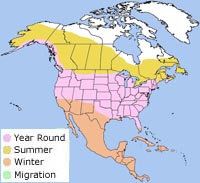 The belted kingfisher is found across Alaska and Canada south through the United States, Mexico and Central America. It winters from southern Canada south to Central America and the Caribbean. The belted kingfisher is found across Alaska and Canada south through the United States, Mexico and Central America. It winters from southern Canada south to Central America and the Caribbean.
Habitat
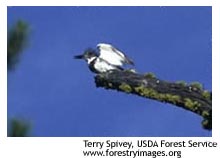 During breeding season, the belted kingfisher is found
along a variety of fresh and saltwater wetlands with sandy banks and clear, still water. It is found near rivers, lakes, streams, marshes, and estuaries. During breeding season, the belted kingfisher is found
along a variety of fresh and saltwater wetlands with sandy banks and clear, still water. It is found near rivers, lakes, streams, marshes, and estuaries.
| |
Diet
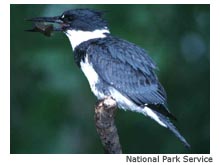 The belted kingfisher
hovers or
perches above clear water looking for prey. Once it spots its prey, it dives headfirst towards the water and snatches up its prey at, or just below, the surface of the water. It returns to its perch and beats its prey against a tree branch to stun it. It then tosses its prey into the air, catches it headfirst, and swallows it! The belted kingfisher also eats frogs, toads, crayfish, crabs, mice,
salamanders, lizards,
and insects. The belted kingfisher
hovers or
perches above clear water looking for prey. Once it spots its prey, it dives headfirst towards the water and snatches up its prey at, or just below, the surface of the water. It returns to its perch and beats its prey against a tree branch to stun it. It then tosses its prey into the air, catches it headfirst, and swallows it! The belted kingfisher also eats frogs, toads, crayfish, crabs, mice,
salamanders, lizards,
and insects.
Life Cycle
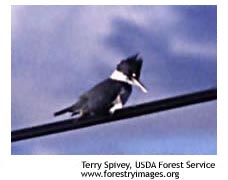 The male belted kingfisher chooses a breeding territory and courts the female by singing to her and bringing her fish. After mating, both the male and female dig a 3-8 foot burrow in a sandy bank. The female lays 6-8 eggs in the burrow.
Both the male and female incubate the eggs for
22-24
days. Both parents feed the chicks regurgitated fish!
The chicks leave the burrow when they are about 28 days old. They stay with their parents for about three weeks. The male belted kingfisher chooses a breeding territory and courts the female by singing to her and bringing her fish. After mating, both the male and female dig a 3-8 foot burrow in a sandy bank. The female lays 6-8 eggs in the burrow.
Both the male and female incubate the eggs for
22-24
days. Both parents feed the chicks regurgitated fish!
The chicks leave the burrow when they are about 28 days old. They stay with their parents for about three weeks.
Behavior
The belted kingfisher is very territorial!
The male chases intruders away from his territory by calling out with a rattling call. The belted kingfisher often has favorite perches along the water that it uses to search for prey. Except for during the breeding season, the belted kingfisher is a solitary bird.
|

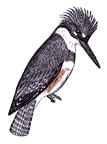

 The belted kingfisher is found across Alaska and Canada south through the United States, Mexico and Central America. It winters from southern Canada south to Central America and the Caribbean.
The belted kingfisher is found across Alaska and Canada south through the United States, Mexico and Central America. It winters from southern Canada south to Central America and the Caribbean.

